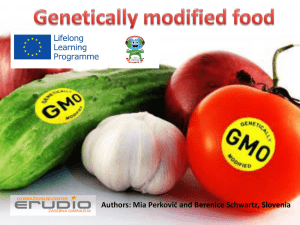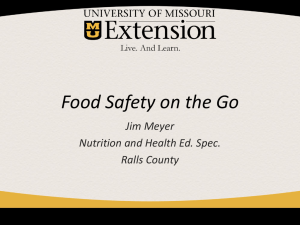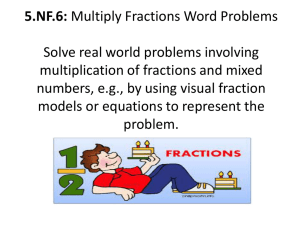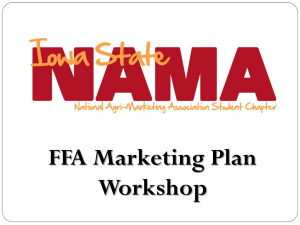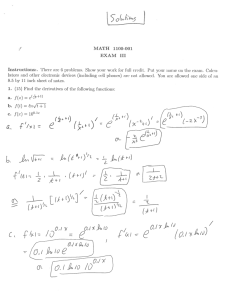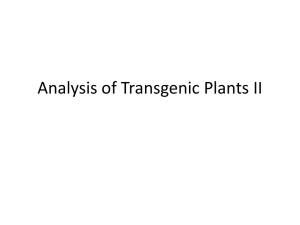GMO’s – The Solution to World Hunger or a
advertisement
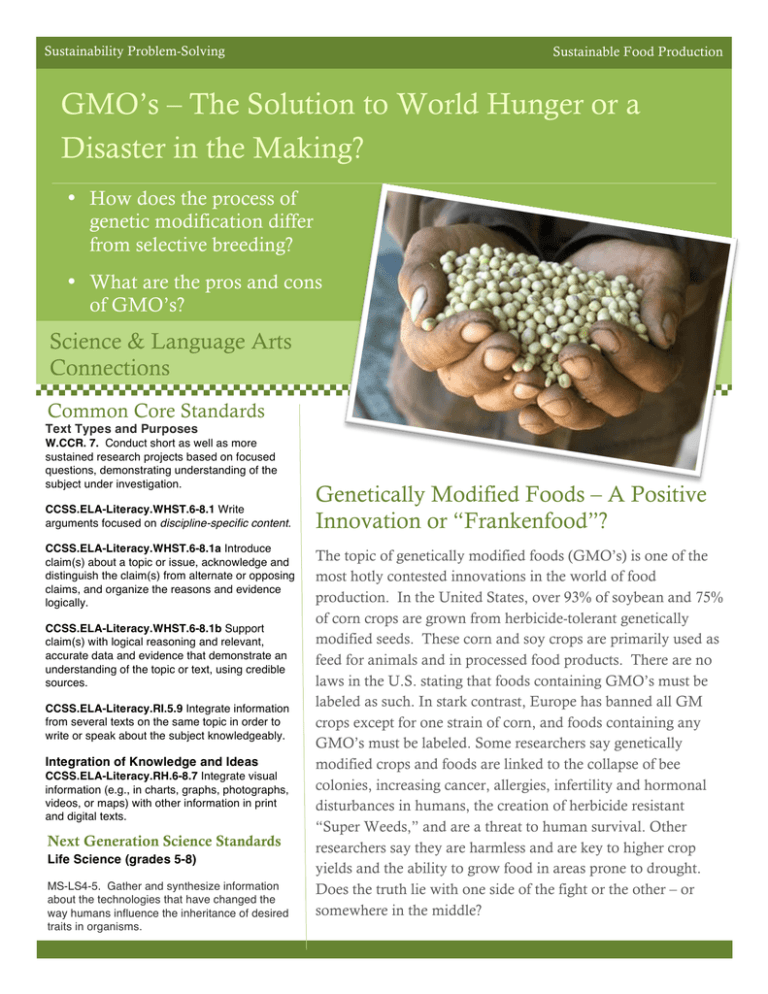
Sustainability Problem-Solving Sustainable Food Production GMO’s – The Solution to World Hunger or a Disaster in the Making? • How does the process of genetic modification differ from selective breeding? • What are the pros and cons of GMO’s? Science & Language Arts Connections Common Core Standards Text Types and Purposes W.CCR. 7. Conduct short as well as more sustained research projects based on focused questions, demonstrating understanding of the subject under investigation. CCSS.ELA-Literacy.WHST.6-8.1 Write arguments focused on discipline-specific content. CCSS.ELA-Literacy.WHST.6-8.1a Introduce claim(s) about a topic or issue, acknowledge and distinguish the claim(s) from alternate or opposing claims, and organize the reasons and evidence logically. CCSS.ELA-Literacy.WHST.6-8.1b Support claim(s) with logical reasoning and relevant, accurate data and evidence that demonstrate an understanding of the topic or text, using credible sources. CCSS.ELA-Literacy.RI.5.9 Integrate information from several texts on the same topic in order to write or speak about the subject knowledgeably. Integration of Knowledge and Ideas CCSS.ELA-Literacy.RH.6-8.7 Integrate visual information (e.g., in charts, graphs, photographs, videos, or maps) with other information in print and digital texts. Next Generation Science Standards Life Science (grades 5-8) MS-LS4-5. Gather and synthesize information about the technologies that have changed the way humans influence the inheritance of desired traits in organisms. Genetically Modified Foods – A Positive Innovation or “Frankenfood”? The topic of genetically modified foods (GMO’s) is one of the most hotly contested innovations in the world of food production. In the United States, over 93% of soybean and 75% of corn crops are grown from herbicide-tolerant genetically modified seeds. These corn and soy crops are primarily used as feed for animals and in processed food products. There are no laws in the U.S. stating that foods containing GMO’s must be labeled as such. In stark contrast, Europe has banned all GM crops except for one strain of corn, and foods containing any GMO’s must be labeled. Some researchers say genetically modified crops and foods are linked to the collapse of bee colonies, increasing cancer, allergies, infertility and hormonal disturbances in humans, the creation of herbicide resistant “Super Weeds,” and are a threat to human survival. Other researchers say they are harmless and are key to higher crop yields and the ability to grow food in areas prone to drought. Does the truth lie with one side of the fight or the other – or somewhere in the middle? Sustainability Problem -Solving Sustainable Food Production Background information: Classical vs. Transgenic Breeding Teacher’s Domain: NOVA/Frontline background essay http://www.teachersdomain.org/resource/tdc02.sci.life.gen.breeding/ Do you want to eat plants whose genes have been manipulated? If not, you should avoid eating produce! Crop plant genes have been mixed and matched by farmers for thousands of years. Assyrian carvings dating back to around 900 B.C. clearly depict the act of plant cross-pollination. Around the same time, Central American farmers were selectively breeding a variety of crop plants, especially corn. For corn that is sweet, potatoes that are non-toxic -- all crop plants, in fact -- you have genetic manipulation to thank. And selective breeding is really just a primitive form of genetic manipulation. When a breeder chooses a male plant and a female plant for breeding, what he or she is really doing is choosing specific genes to combine from those two plants. By hand-delivering pollen (sperm) from the male plant to the female flower (which produces the egg), the breeder intervenes in the natural fertilization process to ensure that traits from the two "best" plants get passed on to their offspring. It's like an arranged marriage for plants. But selective breeding is both imprecise and inefficient. Thousands of genes combine at once, and the offspring plant may not receive the exact combination of genes the breeder had intended. The breeder has no way of knowing whether the desirable genes are in the sperm and egg; one can only guess, based on the parent plants' appearance. Many offspring may need to be produced in order to get one with the desirable trait. So genetic manipulation through selective breeding is a slow process of trial and error. Genetic engineering, however, is a targeted approach that allows scientists to remove specific genes from one organism and insert them into another. The gene recipient is called a genetically modified organism, or GMO (also called a "transgenic"). This efficient technique is also remarkable because it allows genes to be transferred between different species, for example, between a flounder and a strawberry. Classical breeding could never achieve such a thing, since it requires the parent organisms to be of the same species. As genetic engineering techniques improve, more and more GMOs are being grown and put on grocery store shelves. And while the GM food industry touts the benefits of genetic modification, ranging from increased crop yields to enhanced nutritional content of GM foods, the public is not convinced. In fact, despite the United Nations Development Programme's (UNDP) official support of GM foods, many developing countries are opposed to growing or consuming them. Public outcry stems from four main concerns. First, GMOs can interbreed with their non-GM counterparts, moving the foreign genes into "wild" populations. This is especially true in plant populations, since GMO pollen can easily be blown onto non-GM plants. Second, many believe GMOs are unsafe, possibly causing allergic reactions, illness, and even death; however, these claims have not yet been validated. Third, many have a visceral dislike for GMOs because they are just not "natural": strawberries don't mate with flounder. Last but not least, in the U.S., many consumers are outraged because foods containing GMOs are not currently labeled as such, so they can't be identified or avoided. The GM food industry will have to quell the public's misgivings before the technology can be fully implemented. But if the industry can demonstrate that GM foods are, indeed, ecologically harmless and safe for consumers, GM foods may become a predominant part of our future diet. 2 Sustainability Problem -Solving Sustainable Food Production Resources For Teaching About GMO’s • The documentary Food, Inc. is a key resource for students to learn about the industrial food system, GMO’s, some of the economics behind processed foods and factory farming, diet, health and obesity connections, and much more “behind the scenes” of how food is produced. Vivamus vestibulum, lectus interdum dignissim rhoncus, nisi purus condimentum enim, vitae ultrices felis nibh id pede. Nam dictum lacinia diam. Pellentesque venenatis. Praesent laoreet, nunc vel porttitor elementum, sem nisi commodo ante, ut consequat est mi et diam. Praesent dignissim tincidunt libero. Curabitur augue justo, pretium sed, placerat vel, porta eget, pede. • PBS’s POV (Point of View) website has lessons and activities that correlate with the movie, Food, Inc. http://www.pbs.org/pov/foodinc/. • A fun way to pre-test for student knowledge about GMO’s is to have them take the short online interactive quiz on PBS’s POV (Point of View) companion website for the movie Food, Inc.: http://www.pbs.org/pov/foodinc/. Have students click on the “GMO Quiz” on the left side under the navigational heading “Explore.” • The PBS website for “Harvest of Fear,” the special report from FRONTLINE and NOVA, is loaded with information and resources about genetically modified foods, including the science and history of GMO’s, experts’ viewpoints on GM crops, student interactive, video clips and an excellent resource list for research with sites that are both for and against GMO’s. http://www.pbs.org/wgbh/harvest/ video clips available at: www.WatchKnowLearn.org. (Search “Harvest of Fear” and choose the segment “Classical vs. Transgenic Breeding” to learn how foods are genetically modified in the lab.) Morbi neque libero, tincidunt adipiscing, aliquam ut, nonummy in, nisi. Integer eu ante. In aliquam ipsum id nisi. 3 Sustainability Problem -Solving Sustainable Food Production Image: Wikimedia Commons The Perfect Tomato? The Story of Calgene’s “Flavr Savr” This is the story of the very first commercially grown, genetically modified food approved for human consumption. On May 21, 1994, the U.S. FDA (United States Food and Drug Administration) allowed a company named Calgene to produce and sell their “Flavr Savr” tomatoes to consumers. What made the Flavr Savr tomato so special? Tomatoes are a very popular food in the United States and around the world. We eat them sliced raw, cooked and pureed in sauces, and chopped in salads, pastas, salsas and other dishes. We’re used to having tomatoes available for purchase yearround, stacked neatly in large colorful displays in the produce section of the grocery store or market. But tomatoes are only in season most places in the U.S. during the summer months. To have tomatoes on store shelves 365 days a year, they have to be shipped long distances from warmer climates. Fully vine-ripened tomatoes do not ship well. As tomatoes ripen from green to red in color, their flesh gets sweeter, but it also gets softer. Soft tomatoes are easily bruised and damaged during shipping, rendering them unfit for sale Tomatoes are picked from the vine while still green and then ripened using ethylene gas. Image: Wikimedia Commons A variety of heirloom tomatoes. once they reach the grocery store. As a solution to this problem, tomatoes are picked from the vine while still green and then ripened using ethylene gas to turn them red in color. (Ethylene is actually a hormone that is emitted by many fruits and vegetables as they ripen naturally.) 4 . Sustainability Problem -Solving Sustainable Food Production The Perfect Tomato? The Story of Calgene’s “Flavr Savr” (Although tomatoes treated this way might look the same as vine-ripened tomatoes, they don’t taste the same. There are lots of tasty compounds a tomato creates while ripening on the vine, dependent upon the amount of UV light it receives, the surrounding temperature, available soil nutrients and other factors – all of which are absent when it ripens in storage. Today, farmers grow thousands of varieties of tomatoes worldwide. Tomatoes range in size from a gumball to a grapefruit and they can be a combination of colors including red, yellow, orange, pink, purple, black or green. Some tomatoes are perfectly round, others more oval and some are ridged like pumpkins with irregular shapes. But the most commercially successful tomatoes are the classic round, red, spotless variety. Over the generations, farmers have bred plants to produce the largest yield of tomatoes of consistent size and shape. The more fruit an individual tomato plant produces, the less sugar it can invest in each tomato, which is another component of why standard supermarket tomatoes seem to taste so bland. Scientists at the University of California in Berkeley saw that there was room for improvement in the taste of commercially grown tomatoes. The taste issue, plus the fact that tomato DNA was relatively easy to manipulate created an opportunity for scientists to take their work outside of the laboratory and into the marketplace. If they could create a superior-tasting tomato that could be ripened on the vine and safely shipped – they would be sitting on a proverbial (red) gold mine! After over a decade of research, the scientists at Calgene were able to isolate the gene that was responsible for encoding the proteins that caused the tomato’s cell walls to break down as it ripened – the gene that controlled how the fruit softened. They literally removed the gene, made chemical modifications to it and then reinserted it into the tomato, disrupting the gene’s original natural function. www.ars.usda.gov/is/graphics/photos/foodimages.htm At the University of California in Berkeley, Athanasios Theologis and colleagues identified and blocked a gene responsible for ripening, which causes a tomato to soften. 5 . Sustainability Problem -Solving Sustainable Food Production The Perfect Tomato? The Story of Calgene’s “Flavr Savr” This “new” tomato could be left on the vine to ripen and would still stay hard enough to be safely shipped without damage. The assumption was that this would, in turn, create a better tasting fruit than those that were being shipped green and ripened with gas. On May 18, 1994, the FDA (United States Food and Drug Administration) approved Calgene’s new tomato, dubbed the “Flavr Savr,” for sale to consumers. Flavr Savr tomatoes were sold under the MacGregor’s label and began appearing in supermarkets in California and the Midwest. The tomatoes were marketed along with a tomato-shaped promotional and informational brochure. Calgene didn’t want to hide their process from the public. On the back of the brochure, there was an explanation of how the Flavr Savr was developed: "First, we made a copy of a gene which causes softening of tomatoes. Then we put this copy into the plant backwards to slow down the softening gene. Simple enough. But we have to know if this step was successful. So we attach a gene which makes a naturally occurring protein. This protein makes Flavr Savr seeds resistant to the kanamycin contained in our test medium. Now, the results become very easy to read. Those seeds unaffected by the kanamycin carry the reversed gene and will be planted for tomato production. No kanamycin is present in tomatoes grown from Flavr Savr seeds." It was no secret that the Flavr Savr had been genetically modified, but the public didn’t seem to mind – they flew off the grocery store shelves! Some stores even had to resort to rationing customers to purchasing only a limited amount of tomatoes each day in order not to run out of stock to quickly. The Flavr Savr was a hit! Yet by 1997, the FLAVR SAVR tomato was gone. What happened? Watch the “Retro Report” from The New York Times to learn more about the story of Calgene and the Flavr Savr tomato: http://www.nytimes.com/2013/06/24/booming/you -call-that-a-tomato.html 1. Why do they pick and ship “normal” grocery store tomatoes while they are still green? 2. Would you have eaten a “Flavr Savr” tomato? Why or why not? 3. Do you agree or disagree with the genetic modification of foods for human consumption? Explain your reasoning. Resources Charles, D. (2012). How the Taste Of Tomatoes Went Bad (And Kept On Going). NPR Online. Retrieved from: http://www.npr.org/blogs/thesalt/2012/06/28/155917345/how-thetaste-of-tomatoes-went-bad-and-kept-on-going Jabr, F. (2012). Dollars and Scents: The Chemistry of a Delicious Tomato. Scientific American. Retrieved from: http://www.scientificamerican.com/article.cfm?id=delicious-tomatochemistry. Winerip, M. (2013). You Call That a Tomato? The New York Times. Retrieved from: http://www.nytimes.com/2013/06/24/booming/youcall-that-a-tomato.html. 6 Sustainability Problem -Solving Sustainable Food Production GM Foods: The Pros and Cons More Technology Connections Harvest of Fear – Exploring the Fight Over Genetically Modified Food A Frontline/NOVA Special Report http://www.pbs.org/wgbh/harvest/ This PBS site is rich with resources for you and your students to research and explore GMO’s. Students can view video excerpt’s from NOVA/Frontline’s “Harvest of Fear” television episode, read differing viewpoints from various experts in the field, explore interactives about selective breeding and the genetic modification and follow a comprehensive list of useful links to further resources about GMO’s. Engineer a Crop http://www.pbs.org/wgbh/harvest/engineer/ This link is part of the PBS “Harvest of Fear” site. It takes you directly to two separate interactives, Selective Breeding and Transgenic Manipulation, designed to give students a better understanding of two ways that humans engineer crops. Spiderscribe www.spiderscribe.com An online real-time mind-mapping/webbing interactive that students can use to generate their own thinking webs, or can be used as a non-linear visual interface for written group debate. Edmodo www.edmodo.com An educational social media forum for students to communicate with each other and their teacher, Edmodo is great way for students to gather and share information to develop arguments for a more formal class debate or for individual projects. Have students share their research findings: Are you for or against human consumption of GMO’s? What evidence do you have to back up your stance? What arguments from the opposing viewpoint do you anticipate, and how can you effectively counter them? 7 Sustainability Problem -Solving Sustainable Food Production How Image: Wikimedia Commons Project Ideas & Resources on GMO’s Give students a choice of projects that include opportunities for research, critical thinking, communication skills and creativity. Project & Activity Ideas GMO Ad Campaign Persuasive Presentation Informational Interactive Do you think GM foods are suffering from a bad image? Do they need a better marketing campaign to garner greater support from the public? Create a series of advertisements or a public relations campaign for GM foods that you think will help build a more positive image of their benefits to the public consumer. Keep in mind the importance of slogans, logos and advertising techniques such as bandwagon, expert testimony, emotional appeal, etc. Are you for or against human consumption of GMO’s? What evidence do you have to back up your stance? What arguments from the opposing viewpoint do you anticipate, and how can you counter them? The jury is still out for many people about GM foods – are they are good thing or a bad thing? Create an informational resource to help people find answers to their questions about GMO’s and let them decide for themselves. Consider creating a functional Glog, Wiki or e-book to organize and share useful information. Try to anticipate the kinds of questions someone might have (consider surveying your classmates and family members to help generate ideas) and make sure you include resources to answer the most common ones. Create a presentation (Powerpoint, Poster Talk, Photo Peach, Prezi, etc.) to persuade your audience to agree with you and present it to your classmates. Give a minimum of three (3) points to support your argument. Make sure they are strong ones! *see “Viewpoint” assignment sheet *see “Viewpoint” assignment sheet 8 Sustainability Problem -Solving Sustainable Food Production Project and Activity Ideas - Continued “Silent” Debate Activity Create Your Own GMO Use a Web 2.0 tool such as Spiderscribe or Edmodo to allow students to engage in written debate for and against the use of GMO’s for human consumption. Students can link websites, paste text excerpts, post images and generate their own questions and responses. (Be sure to have a class discussion about rules of online etiquette beforehand, so students understand expectations for appropriate responses to statements they disagree with.) What would your students design if they could create their own GMO? What do they think consumers would like to see improved in a natural product (think about the Flvr Savr story) or what would alterations might make life easier for farmers or food distributors? Would they choose to modify a fruit, vegetable, grain or animal food crop? What attributes would they give their new food and which organism(s) would they need to draw these attributes from? What would they name their creation and how would they market it? What would it look like…or would it look the same as the non-GMO version? What could be some of the possible downsides of their new creation? This activity can be a useful precursor to students’ individual projects, by giving them a fun way to discover useful research resources as a class. 9 Viewpoint: GENETICALLY MODIFIED FOODS In this unit on Sustainable Food Production, we have been researching and discussing the highly controversial topic of GM Foods. There are scientists, businesspeople, politicians, farmers, and everyday citizens who have very divergent beliefs about the safety and value of GM Foods. Your task is to design a professional-level presentation to inform the public about GM foods. Create a strong argument in your own words that includes valid supporting evidence to persuade your audience to agree with your viewpoint. Remember to address any opposing arguments! If you are undecided on the issue you may choose to create a balanced piece presenting what you perceive to be the main pros/cons of both sides of the issue with the intent to inform versus persuade. Remember to reference all sources for your information and graphics. You will be expected to present your project to your classmates. Example of a “Pro Genetically Modified Foods” glog created by a 5th grade student at GEM Academy. Most of the graphics are live links to other online resources. The live glog site can be accessed at: http://gemsacademy.edu.glogster.com/5baxter/
